What Is Red Light Therapy For Eyes?
Could the solution to better eye health be as simple as light?
This article will explore the innovative approach of red light therapy specifically for eye health. We’ll discuss what red light therapy entails, its benefits, considerations, alternatives, and answer frequently asked questions about this promising treatment option.
Key Takeaways
- Red light therapy for eyes utilizes low-level wavelengths of light to promote healing and reduce inflammation.
- Potential benefits include improved vision, faster recovery from eye surgeries, and reduction of symptoms associated with dry eyes.
- Precautions are essential, including understanding the proper application and potential side effects.
What is Red Light Therapy For Eyes?
Red light therapy, also known as low-level laser therapy (LLLT), involves the application of specific wavelengths of light to stimulate cellular function. This therapy harnesses red and near-infrared light to penetrate the skin and tissues, offering therapeutic effects.
When applied to eye health, red light therapy is thought to aid in stimulating cellular regeneration, improving blood circulation, and reducing inflammation. Some clinical studies suggest that it may help alleviate various ocular conditions, including age-related macular degeneration, diabetic retinopathy, and dry eye syndrome.
How Does Red Light Therapy Work?
Red light therapy operates on the principle of photobiomodulation, where light photons are absorbed by cells, leading to increased ATP production. ATP, or adenosine triphosphate, is the energy currency of cells, essential for repair processes and overall cellular health.
The specific wavelength of red light (typically around 630-670 nm) is particularly effective in penetrating tissue and has been shown to enhance healing at a cellular level.
What are the Benefits of Red Light Therapy For Eyes?
Exploring the benefits of red light therapy can provide insights into why many are turning to this method for enhancing eye health.
Enhanced Vision
Many users report clearer vision after undergoing red light therapy. This benefit may be associated with improved blood flow to the retina and stimulation of photoreceptors, which could be particularly beneficial for older adults experiencing age-related vision issues.
Reduced Eye Fatigue
With modern lifestyles often involving prolonged screen time, red light therapy can help alleviate symptoms of eye strain and fatigue. The therapy may assist in balancing the natural circadian rhythms, leading to reduced discomfort in the eyes.
Faster Recovery from Eye Conditions
For individuals recovering from surgeries or suffering from eye injuries, red light therapy might speed up the healing process. By enhancing cellular repair mechanisms, this therapy could promote a quicker return to optimal eye function.
Relief from Dry Eye Symptoms
Red light therapy has shown promise in treating dry eyes by stimulating the meibomian glands, which produce the oils necessary for healthy tear film. Improved oil production can lead to a reduction in dryness and irritation.
Is it Possible to Use Red Light Therapy at Home?
Using red light therapy for eyes at home is increasingly feasible with the availability of consumer-grade devices. However, proper precautions and guidance are essential to ensure safety and efficacy.
What are the Advantages of Home Use?
Convenience: Home use allows for flexibility in timing and frequency of treatments without the need for clinical visits.
Cost-effective: Investing in a home device can be more economical in the long run compared to repeated professional sessions.
Accessible: Many users find it more comfortable and less intimidating to engage in therapy at home.
What are the Disadvantages of Home Use?
Lack of professional guidance: Individualized assessment and supervision by an eye health professional may be missed, potentially leading to improper use.
Read all about it Is Red Light Therapy Good for Your Heart?
Device variability: The effectiveness of over-the-counter devices can vary significantly, requiring users to conduct adequate research before purchase.
Risk of misuse: Without proper education, users may apply treatments incorrectly, which could reduce efficacy or lead to adverse effects.
What are the Things to Consider Before Starting Red Light Therapy?
Before beginning red light therapy for eyes, several factors should be taken into account to ensure a safe and beneficial experience.
Consult a Healthcare Professional
Always consult with an eye care specialist to determine if red light therapy is suitable for your specific condition and to receive recommendations on safe usage.
Understand the Device Specifications
Research and select a device that meets clinically approved specifications for the intended treatment area. Consider factors like wavelength, power density, and FDA approval.
Assess Your Current Health Conditions
Certain medical conditions, such as photosensitivity or existing eye issues, may preclude the safe use of red light therapy. Assess your health status before initiating treatment.
What are the Alternatives to Red Light Therapy for Eye Health?
If red light therapy is not suitable for your needs or preferences, several alternative treatments may provide similar benefits.
Warm Compresses
Using warm compresses can alleviate dry eye symptoms and enhance blood circulation to the eyes. This simple method is especially useful for those with meibomian gland dysfunction.
Eye Drops or Artificial Tears
Over-the-counter eye drops can offer immediate relief to dry eyes. Regular use can help keep the eyes lubricated, particularly for those working in dry environments or spending long hours on screens.
Ocular Supplements
Certain supplements containing omega-3 fatty acids or antioxidants may support overall eye health. These are particularly relevant for individuals seeking to enhance retinal health or combat age-related vision changes.
Conclusion: Is it Recommended to Try Red Light Therapy For Eyes?
In summary, red light therapy for eyes presents a promising avenue for enhancing eye health, with potential benefits ranging from improved vision to relief from dry eye symptoms. However, individuals should approach this therapy with careful consideration, consulting eye care professionals and evaluating the suitability of devices and techniques. Ultimately, if you are seeking a new method to support eye health, red light therapy is worth considering as part of a comprehensive approach.
Frequently Asked Questions
Is red light therapy safe for everyone?
Red light therapy is generally considered safe for most people. However, those with specific eye conditions or photosensitivity should consult a healthcare professional before initiating treatment.
How often should I use red light therapy for eyes?
Typically, sessions can vary between 10 to 20 minutes, 2 to 3 times per week. However, it’s best to follow the recommendations of a healthcare provider or the device manufacturer for optimal results.
Are there any side effects of red light therapy for eyes?
Most users report minimal side effects, but some may experience temporary discomfort or eye strain. If these symptoms persist, it is advisable to stop treatment and consult a professional.
Can I use any red light device for eye therapy?
Not all red light devices are suitable for eye therapy. It’s crucial to choose devices specifically designed for ocular use to ensure safety and effectiveness.
Learn more in Lotion for Red Light Therapy?
What should I do if I experience discomfort during treatment?
If you experience discomfort during red light therapy, it is essential to cease use immediately and consult an eye care professional for guidance.






